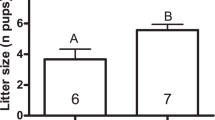Abstract
Brook stickleback (Culaea inconstans) share habitat and predators with cyprinid species, and they exploit the alarm pheromone of fathead minnows (Pimephales promelas) to avoid areas of high predation risk. In this field experiment, we measured the retention and duration of area avoidance by brook stickleback from areas marked with alarm pheromone of fathead minnows. Area avoidance was greatest during the first 2 hr after the source of the alarm pheromone was removed (P<0.05), but after 4 hr, area use was not significantly different from premarking levels. This study shows that brook stickleback: (1) use the alarm pheromone of fathead minnows to avoid high risk areas, (2) continue to avoid locations associated with predation risk after the source of the pheromone has gone, and (3) avoid risky areas temporarily, and resume use of risky areas after 2–4 hr. This behavioral response by stickleback to minnow alarm pheromone could serve to minimize risk of predation.
Similar content being viewed by others

References
Cerri, R.D., andFraser, D.F. 1983. Predation and risk in foraging minnows: Balancing conflicting demands.Am. Nat. 121:552–561.
Chivers, D.P., andSmith, R.J.F. 1993. The role of olfaction in chemosensory-based predator recognition in the fathead minnow,Pimephales promelas.J. Chem. Ecol. 19:623–633.
Chivers, D.P., andSmith, R.J.F. 1994a. The role of experience and chemical alarm signalling in predator recognition by fathead minnows,Pimephales promelas J. Fish Biol. 44:273–285.
Chivers, D.P., andSmith, R.J.F. 1994b. Intra- and interspecific avoidance of areas marked with skin extract from brook sticklebacks (Culaea inconstans) in a natural habitat.J. Chem. Ecol. 20:1517–1524.
Chivers, D.P., andSmith, R.J.F. 1994c. Fathead minnows,Pimephales promelas, acquire predator recognition when alarm substance is associated with the sight of unfamiliar fish.Anim. Behav. 48:597–605.
Chivers, D.P., andSmith, R.J.F. 1994d. Fathead minnows (Pimephales promelas) learn to recognize chemical stimuli from high risk habitats by the presence of alarm substance.Behav. Ecol. In press.
Clark, C.W., andMangel, M. 1984. Foraging and flocking: Information in an uncertain environment.Am. Nat. 123:626–641.
Frisch, K. Von 1941. über einen Schreckstoff der Fischhaut und seine biologische Bedeutung.Z. Vergl. Physiol. 29:46–145.
Godin, J.-G.J., andSproul, C.D. 1988. Risk taking in parasitized sticklebacks under threat of predation: Effects of energetic need and food availability.Can. J. Zool. 66:2360–2367.
Göz, H. 1941. über den Art- und Individualgeruch bei Fischen.Z. Vergl. Physiol. 29:1–45.
Krause, J. 1994. Transmission of fright reaction between different species of fish.Behaviour 127:37–48.
Lima, S.L., andDill, L.M. 1990. Behavioral decisions made under the risk of predation: A review and prospectus.Can. J. Zool. 68:619–648.
Magurran, A. E. 1989. Acquired recognition of predator odour in the European minnow (Phoxinus phoxinus).Ethology 82:216–233.
Martel, G., andDill, L.M. 1993. Feeding and aggressive behaviors in juvenile coho salmon (Oncorhynchus kisutch) under chemically-mediated risk of predation.Behav. Ecol. Sociobiol. 32:365–370.
Mathis, A., andSmith, R.J.F. 1992. Avoidance of areas marked with a chemical alarm substance by fathead minnows (Pimephales promelas) in a natural habitat.Can. J. Zool. 70:1473–1476.
Mathis, A., andSmith, R.J.F. 1993a. Chemical alarm signals increase the survival time of fathead minnows (Pimephales promelas) during encounters with northern pike (Esox lucius).Behav. Ecol. 4:260–265.
Mathis, A., andSmith, R.J.F. 1993b. Intraspecific and cross-superorder responses to alarm signals by brook stickleback.Ecology 74:2395–2404.
Metcalfe, N.B., Huntingford, F.A., andThorpe, J.E. 1987. The influence of predation risk on the feeding motivation and foraging strategy of juvenile Atlantic salmon.Anim. Behav. 35:901–911.
Milinski, M. 1985. Risk of predation of parasitized sticklebacks (Gaslerosteus aculeatus L.) under competition for food.Behaviour 93:203–216.
Milinski, M. 1993. Predation risk and feeding behavior, pp. 285–305,in T.J. Pitcher (ed.). The Behaviour of Teleost Fishes, 2nd ed. Chapman and Hall, London.
Milinski, M., andHeller, R. 1978. Influence of a predator on the optimal foraging behavior of sticklebacks (Gasterosteus aculeatus L.).Nature 275:642–644.
Pfeiffer, W. 1960. über die Schreckreaktion bei Fischen und die Herkunft des Schreckstoffes.Z. Vergl. Physiol. 43:578–614.
Pfeiffer, W. 1963. The fright reaction in North American fish.Can. J. Zool. 41:69–77.
Pitcher, T.J.,Magurran, A.E. andAllan, J.R. 1983. Shifts of behaviour with shoal size in cyprinids. Proceedings, 3rd British Freshwater Fisheries Conference pp. 220–228.
Pitcher, T.J., Lang, S.H., andTurner, J.A. 1988. A risk-balancing trade off between foraging rewards and predation in a shoaling fish.Behav. Ecol. Sociobiol. 22:225–228.
Power, M.E., Matthews, W.J. andStewart, A.J. 1985. Grazing minnows, piscivorous bass and stream algae: Dynamics of a strong interaction.Ecology 66:1448–1456.
Scott, W.B., andCrossman, E.J. 1973. Freshwater Fishes of Canada. Fisheries Research Board of Canada, Bulletin 184. 966 pp.
Seghers, B.H. 1974. Geographic variation in the responses of guppies (Poecilia reticulata) to aerial predators.Oecologia 14:93–98.
Siegel, S., andCastellan, N.J., Jr. 1988. Nonparametric Statistics for the Behavioral Sciences, 2nd ed. McGraw-Hill, New York.
Smith, R.J.F. 1982. The adaptive significance of the alarm substance-fright reaction system, pp. 327–342,in T.J. Hara (ed.). Chemoreception in Fishes. Elsevier, Scientific, Amsterdam.
Smith, R.J.F. 1992. Alarm signals in fishes.Rev. Fish Biol. Fish. 2:33–63.
Smith, R.J.F., Lawrence, B.J., andSmith, M.J. 1991. Cross-reactions to skin extract between two gobies,Asterropteryx semipunctatus andBrachygobius sabanus.J. Chem. Ecol. 17:2253–2259.
Suboski, M.D., Bain, S., Carty, A.E., McQuoid, L.M., Seelen, M.I., andSeifert, M. 1990. Alarm reaction in acquisition and social transmission of simulated predator recognition by zebra danio fish (Brachydanio rerio).J. Comp. Psychol. 104:101–112.
Werner, E.E., Gilliam, J.F., Hall, D.J., andMittelbach, G.G. 1983. An experimental test of the effects of predation risk on habitat use in fish.Ecology 64:1540–1548.
Author information
Authors and Affiliations
Rights and permissions
About this article
Cite this article
Wisenden, B.D., Chivers, D.P. & Smith, R.J.F. Risk-sensitive habitat use by brook stickleback (Culaea inconstans) in areas associated with minnow alarm pheromone. J Chem Ecol 20, 2975–2983 (1994). https://doi.org/10.1007/BF02098403
Received:
Accepted:
Issue Date:
DOI: https://doi.org/10.1007/BF02098403



